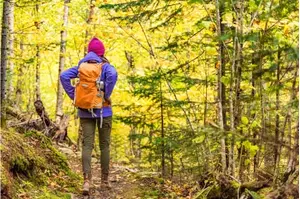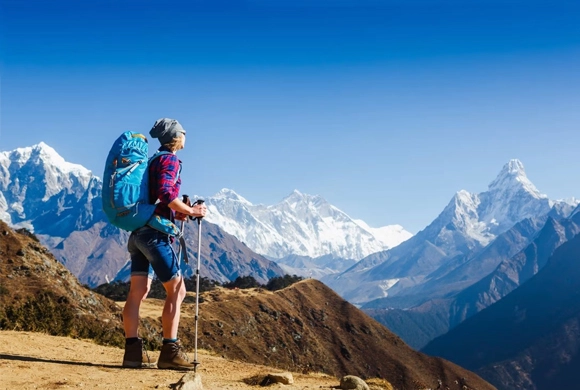Trekking 101: Embark on an Adventure
This article explores the world of trekking, distinguishing it from hiking and highlighting its appeal as an adventurous journey. It delves into the motivations behind trekking, outlines the necessary preparations, and offers insights into the materials and equipment required. The article also touches on safety measures, the importance of leaving no trace, and the mental and physical readiness essential for a successful trekking experience. Whether you're a novice or an experienced trekker, this article provides valuable insights into this exhilarating outdoor pursuit.
Trekking: Exploring Nature's Beauty and Your Own Limits.

Trekking is a thrilling and adventurous outdoor activity that allows you to explore the natural beauty of the world while challenging your physical abilities.
Choose Your Trekking Destination
Selecting the right trekking destination is crucial to ensuring an enjoyable experience. Factors to consider include your level of fitness, the time of year, the type of terrain you prefer, and the level of difficulty you are comfortable with. Research your options and consider well-known trekking destinations like the Himalayas, the Andes, the Alps, or even national parks in your own country.

Plan and Prepare
Before embarking on a trekking adventure, thorough planning and preparation are essential. Here's what you need to do:
a. Fitness: Build your stamina and strength through regular physical exercise, as trekking can be physically demanding.
b. Gear: Invest in appropriate trekking gear, including hiking boots, weather-appropriate clothing, a backpack, trekking poles, and a good-quality tent.
c. Route Research: Study your chosen trekking route, understand the weather conditions, trail difficulty, and necessary permits.
d. Packing: Pack essentials such as food, water, first-aid supplies, navigation tools, and proper identification. Be mindful of carrying a manageable load.
Materials and Equipment's for Trekking
When preparing for a trekking adventure, having the right materials and equipment is crucial to ensure your safety and comfort during the journey. Here's a comprehensive list of materials and equipment you should consider for your trekking trip:
- Backpack: A sturdy and comfortable backpack with enough capacity to carry your gear, food, and water is essential. Look for a backpack with adjustable straps and ample pockets for organization.
- Trekking Boots/Shoes: Invest in high-quality, waterproof, and durable trekking boots or shoes that provide good ankle support and grip for various terrains.
- Clothing:
- Moisture-wicking base layers: To keep you dry and comfortable.
- Insulating layers: Depending on the climate and season.
- Waterproof and windproof jacket and pants: To protect against the elements.
- Hats, gloves, and scarves: To protect from cold or sun.
- Quick-dry, breathable socks: Several pairs of moisture-wicking hiking socks are recommended.
- Trekking Poles: These help with balance and reduce strain on your knees, especially during descents.
- Tent: If you plan on camping during your trek, invest in a lightweight, durable tent that suits your needs and can withstand the weather conditions of your destination.
- Sleeping Bag and Pad: Choose a sleeping bag suitable for the expected temperatures and a comfortable sleeping pad for insulation and cushioning.
- Cooking Equipment:
- Portable stove: To cook meals and boil water.
- Cookware: A lightweight pot, pan, and utensils.
- Fuel canisters: If using a gas stove.
- Water Filtration: Carry a water filtration system, such as a portable water filter or purification tablets, to ensure safe drinking water during your trek.
- Food: Pack lightweight, non-perishable, high-energy foods like energy bars, trail mix, dehydrated meals, and snacks.
- Navigation Tools:
- Maps: Detailed maps of the trekking area.
- Compass or GPS device: For navigation and orientation.
- Headlamp/Flashlight: Essential for lighting your way at night or in low-light conditions.
- First Aid Kit: A well-stocked first aid kit should include bandages, antiseptic wipes, pain relievers, blister treatment, and any personal medications.
- Sun Protection:
- Sunscreen: A high SPF sunscreen to protect your skin from UV rays.
- Sunglasses: With UV protection.
- Lip balm with SPF.
- Personal Identification and Important Documents: Keep your identification, permits, and emergency contact information in a waterproof pouch or bag.
- Backpacking Gear:
- Multi-tool or knife
- Duct tape and repair kits for gear
- Trash bags for waste disposal
- Ziplock bags to keep items dry
- Clothing Accessories:
- Gaiters: To keep debris out of your boots.
- Bandana or buff: Useful for various purposes, including sun protection and wiping sweat.
- Optional Extras:
- Camera: To capture the breathtaking views.
- Trekking poles: For added stability and reduced strain on your legs.
- Insect repellent: Depending on the destination and season.
- Personal hygiene items: Toothbrush, toothpaste, and biodegradable soap.
- Emergency Communication Device: In remote areas, a satellite phone or locator beacon can be a lifesaving tool in case of emergencies.
Safety First
Safety should be your top priority when trekking. Follow these tips to ensure a secure journey:
a. Inform Others: Let someone know your trekking plans, including your itinerary and expected return time.
b. Stay Hydrated: Carry an adequate supply of water and purification methods to avoid dehydration.
c. Know Basic First Aid: Learn basic first aid techniques and carry a well-stocked first aid kit.
d. Navigation: Familiarize yourself with map reading, and carry a GPS device or compass for navigation.
e. Weather Awareness: Stay updated on the weather conditions for your trekking destination and be prepared for sudden changes.
Leave No Trace
Trekking is an opportunity to connect with nature and leave a minimal impact on the environment. Follow the Leave No Trace principles:
a. Stay on Marked Trails: Stick to designated paths to prevent erosion and habitat destruction.
b. Dispose of Waste Properly: Pack out all trash and dispose of human waste in designated areas.
c. Respect Wildlife: Keep a safe distance from animals, and never feed them.
d. Minimize Campfire Impact: Use a camp stove instead of open fires to reduce the risk of forest fires.
Physical and Mental Preparedness
Trekking can be physically and mentally demanding. To fully enjoy the experience, keep these points in mind:
a. Acclimatization: If trekking at high altitudes, take time to acclimatize to prevent altitude sickness.
b. Listen to Your Body: Pay attention to your body's signals and rest when needed to prevent overexertion.
c. Mindset: Stay positive and patient during challenging moments; a strong mental attitude can be just as important as physical fitness.
Top 10 Trekking Destinations for Adventure Enthusiasts
Trekking is an exhilarating way to explore the world's natural beauty, and for adventure enthusiasts, choosing the right destination can make all the difference. Here, we present a curated list of the top 10 trekking destinations that promise stunning landscapes, challenging terrain, and unforgettable experiences. Whether you're a seasoned trekker or just starting, these destinations offer something for every adventurer.
- Himalayas, Nepal: The Everest Base Camp trek, Annapurna Circuit, and Langtang Valley provide a diverse range of trekking experiences amidst the world's highest peaks.
- Torres del Paine, Chile: Located in Patagonia, this national park offers breathtaking vistas of glaciers, lakes, and rugged mountains.
- Inca Trail, Peru: Trek to the ancient city of Machu Picchu through lush forests, stone-paved paths, and Incan ruins.
- Trekking in the Alps, Europe: Traverse the iconic Mont Blanc Circuit, the Tour du Mont Blanc, or the Dolomites for stunning alpine scenery.
- Tiger's Nest Monastery, Bhutan: Hike to this iconic monastery perched on the edge of a cliff for a spiritual and visual treat.
- Zion National Park, USA: The Zion Narrows and Angels Landing offer unique experiences in the heart of the American Southwest.
- Annapurna Sanctuary, Nepal: A shorter but equally rewarding trek with breathtaking views of the Annapurna and Machapuchare peaks.
- Kilimanjaro, Tanzania: Conquer Africa's highest peak for an epic adventure with diverse landscapes, from rainforests to glaciers.
- Haute Route, Switzerland and France: A classic trek connecting Chamonix in France to Zermatt in Switzerland, offering stunning alpine vistas.
- Salkantay Trek, Peru: An alternative to the Inca Trail, this trek traverses high-altitude mountain passes and lush cloud forests.
These destinations provide a taste of the diverse experiences trekking can offer, from challenging high-altitude treks to serene walks through ancient forests. No matter your skill level, there's a trekking destination on this list that can fulfill your desire for adventure and exploration.

People also ask (FAQ)
What is difference between trekking and hiking?
Is trekking a journey?
Is trekking a walking?
Why do people do trekking?
How can I do trekking?
What we call a person who loves trekking?
What is an example of trekking?
Difference between Trekking and Hiking:
- Trekking and hiking are often used interchangeably, but there is a subtle difference. Hiking typically involves walking on well-marked and maintained trails or paths, usually for shorter durations, and can be less strenuous. Trekking, on the other hand, typically involves longer journeys, often in remote or rugged terrain, and may require multi-day expeditions with more challenging conditions.
Is Trekking a Journey?
- Yes, trekking is a type of journey. It involves exploring natural landscapes on foot, often over an extended period, and it may encompass varying terrains and altitudes.
Is Trekking Walking?
- Yes, trekking is a form of walking. It is a long-distance, often arduous walk, typically in natural environments like mountains, forests, or wilderness areas.
Why Do People Do Trekking?
- People undertake trekking for various reasons, including:
- To connect with nature and enjoy the outdoors.
- To challenge themselves physically and mentally.
- To explore remote and pristine landscapes.
- For adventure, relaxation, or to escape from urban life.
- To appreciate and experience diverse cultures and traditions.
- To build endurance and physical fitness.
How Can I Do Trekking?
- To start trekking, follow these steps:
- Choose a trekking destination and research the area.
- Prepare and gather the necessary gear and equipment.
- Plan your trek carefully, considering routes, permits, and logistics.
- Stay physically fit through regular exercise.
- Learn basic navigation skills.
- Join trekking groups or find experienced guides if you're a beginner.
- Follow safety guidelines and leave-no-trace principles.
What Do We Call a Person Who Loves Trekking?
- A person who loves trekking is often called a trekker or hiker. They are individuals who have a passion for exploring natural environments on foot.
Example of Trekking:
- An example of trekking could be embarking on a multi-day journey through the Himalayan mountains, where you hike through rugged terrain, explore remote villages, and experience the stunning natural beauty of the region. Another example could be trekking in a national park, like hiking the Appalachian Trail in the United States, which spans over 2,000 miles of challenging wilderness.
Trekking offers a unique opportunity to explore the beauty of the natural world while pushing your physical and mental limits. By choosing the right destination, planning meticulously, prioritizing safety, and practicing responsible trekking, you can make your journey an unforgettable and rewarding experience. So, gear up, embrace the wilderness, and embark on your next trekking adventure with confidence.



